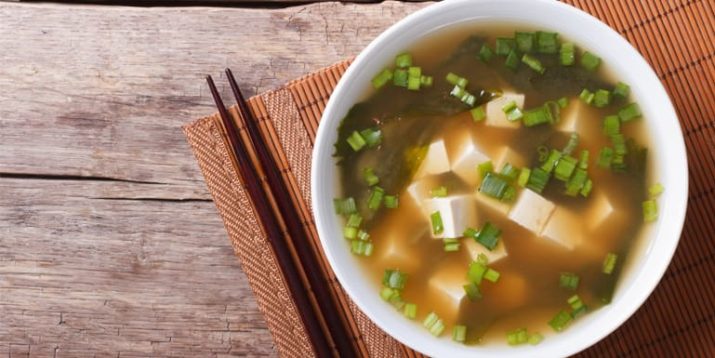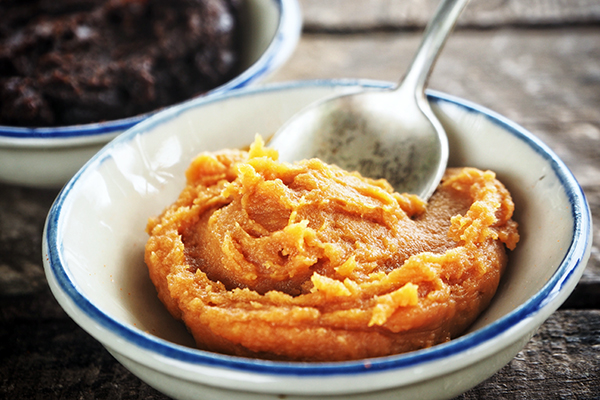How to Make Miso Soup

Miso soup is simple and versatile, providing a blank canvas for your favorite Asian-inspired ingredients.
And since it’s a broth-based soup, sipping on it before a meal — or using it as the basis for one — can help you fill up for fewer calories.
Miso soup is one of the staples you can enjoy on BODi’s Ultimate Reset,* a 21-day nutrition program that supports digestive and overall health.
If you’re planning to complete Ultimate Reset, or you’re simply looking for ways to eat healthier, it’s a good idea to learn how to make your own miso soup, rather than using prefab powdered versions.
Bypass the shelf-stable miso packets and head to the refrigerator case at your grocers.
According to Leila Bakkum, the national sales director for Miso Master, you want to choose a miso that’s unpasteurized so it can retain all the beneficial probiotics and enzymes that are created when the soybeans (or other legumes/grains) are inoculated and allowed to ferment naturally.
Traditionally, the broth for miso starts with kombu, or dried seaweed, and/or bonito, dried tuna flakes.
(Both can be found in the Asian aisle of most larger supermarkets or can be purchased online.)
What Is Miso?

Miso is a paste made from fermenting cooked soybeans with salt and koji, cooked rice or soybeans that have been inoculated with a fermentation culture called Aspergillus oryzae.
It’s aged in barrels for weeks, months, or years at ambient temperature; the slow fermentation results in complex flavors rich in umami, the savory “fifth taste.”
While commercial miso soup varieties can be high in salt, miso itself is far lower in sodium than table salt. One teaspoon of miso contains about eight to 10 calories and anywhere from 180 mg to 240 or more mg sodium, compared with 2,240 mg sodium in one teaspoon of iodized table salt.
Unpasteurized miso that hasn’t been boiled contains probiotics (a.k.a. gut-friendly bacteria), though not a major amount in a one-teaspoon serving.
But heating the miso, as is the case when making soup, can destroy the probiotics.
Miso soup can be gluten-free, as long as you use gluten-free miso. Many brands, including Miso Master and Eden, have certified gluten-free varieties.
You can use any type of miso to make soup; it really depends on your mood and palette. The three main types of miso include: red, yellow, and white.
This quick primer shows you the differences between the varieties:
Red Miso
Flavor: Red miso is fermented for the longest amount of time (up to three years) with the highest percentage of soybeans. It’s the saltiest, and has a pungent flavor.
How to use: Use sparingly because it’s so strong to flavor soups, marinades, and sauces.
Yellow Miso
Flavor: Fermented for about a year, yellow miso has an earthy, slightly acidic and less salty (compared to red) flavor.
How to use: Use in soups, sauces, and glazes.
White Miso
Flavor: Usually fermented for a few weeks with the smallest percentage of soybeans, white miso has a light, slightly sweet flavor.
How to use: Incorporate in salad dressings, sauces, soups, and even as a dairy replacement in some recipes.
How to Make Miso Soup at Home:
Roasted Ginger and Vegetable Miso Broth
Ingredients
- parchment paper
- 1 bunch green onions, roots trimmed and discarded, whites only, reserve greens for variation listed below, if desired
- 1 bulb garlic
- 1 large onion, sliced in half
- 1 1-inch piece of ginger, unpeeled, cut in half
- 4 cups low-sodium organic vegetable broth
- 1 cup water
- 1 cup crumbled, dried shiitake mushrooms
- 1 sheet dried kombu seaweed
- ¼ tsp. sea salt (or Himalayan salt)
- 1 Tbsp. + 1 tsp. white miso paste
Instructions
-
Preheat oven to 425° F.
-
Line large baking sheet with parchment paper.
-
Top prepared pan with whites from green onions, garlic, onion, and ginger. Bake for 30 minutes, or until brown and fragrant. Cool for 10 minutes.
-
When garlic is cool enough to touch, squeeze bulbs to release roasted cloves. (Roasted vegetables can be refrigerated at this point for up to two days if you want to make the recipe later.)
-
Heat roasted vegetables, broth, water, mushrooms, seaweed, and salt in large saucepan over high heat. Bring to a boil. Reduce heat to medium-low; gently boil for 30 minutes. Remove from heat.
-
Strain broth mixture, reserving mushrooms for variation listed below, if desired.
-
Combine ¼ cup broth mixture and miso paste in a medium bowl; whisk to blend.
-
Add miso mixture back to broth; mix well.
Recipe Notes
Note: Nutritional information is per serving for the Roasted Ginger and Vegetable Miso Broth only.
Tips:
- If not serving all portions at once, measure out 1 cup broth and add 1 tsp. miso paste for each serving.
- Store soup in an airtight container in the refrigerator for up to 5 days.
- For serving remaining soup later, reheat broth mixture (do not bring to a boil). Add 1 tsp. miso paste per serving; whisk to blend.
Add-in Variations (per serving):
Egg, soft boiled, cut in half – Add 1 whole egg for each serving. Add ½ red container.
Garlic or fresh ginger, grated – Add 1 tsp. per serving.
Green onions – Add 1 thinly sliced green onion per serving.
Mushrooms, cremini, thinly sliced – Add ½ cup per serving. Add ½ green container.
Noodles, cooked – Add ½ cup whole-grain egg noodles, gluten-free pasta, rice pasta, or quinoa pasta for each serving. Add 1 yellow container. Or you can add 3½-oz. veggie (shirataki) noodles, which are free.
Noodles, shirataki – Add 3½-oz. shirataki noodles, which are free.
Shrimp, cooked – Add ¼ cup + 2 Tbsp. (approx. 2 oz.) for each serving. Add ½ red container.
Spinach (or baby greens) – Add 1 cup for each serving. Add 1 green container.
Tofu, firm, drained, cubed – Add ¼ cup + 2 Tbsp. (approx. 2 oz.) for each serving. Add ½ red container.
Suggested garnishes:
- Toasted sesame oil
- Toasted sesame seeds
- Nori (seaweed) flakes
- Pinch crushed red pepper
Portion Fix Containers
1½ Green
2B Mindset Plate It!
Makes a great veggie as part of lunch or dinner.
*To learn more about BODi’s Ultimate Reset and 3-Day Refresh, check out our cleanse hub.
